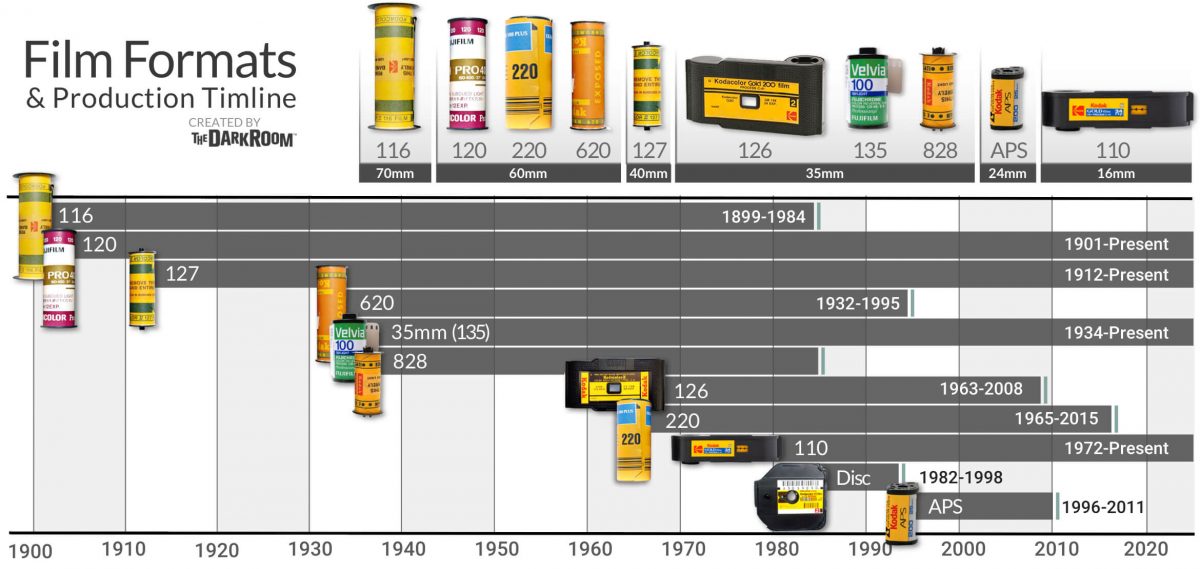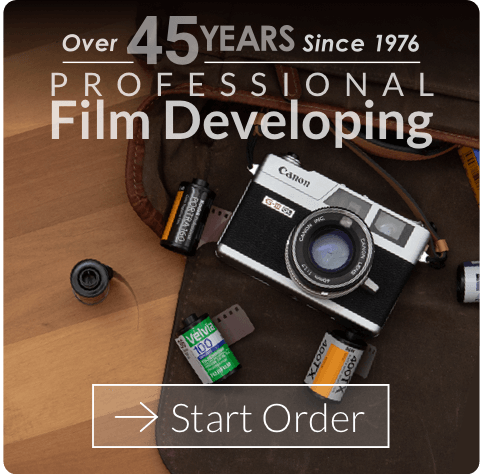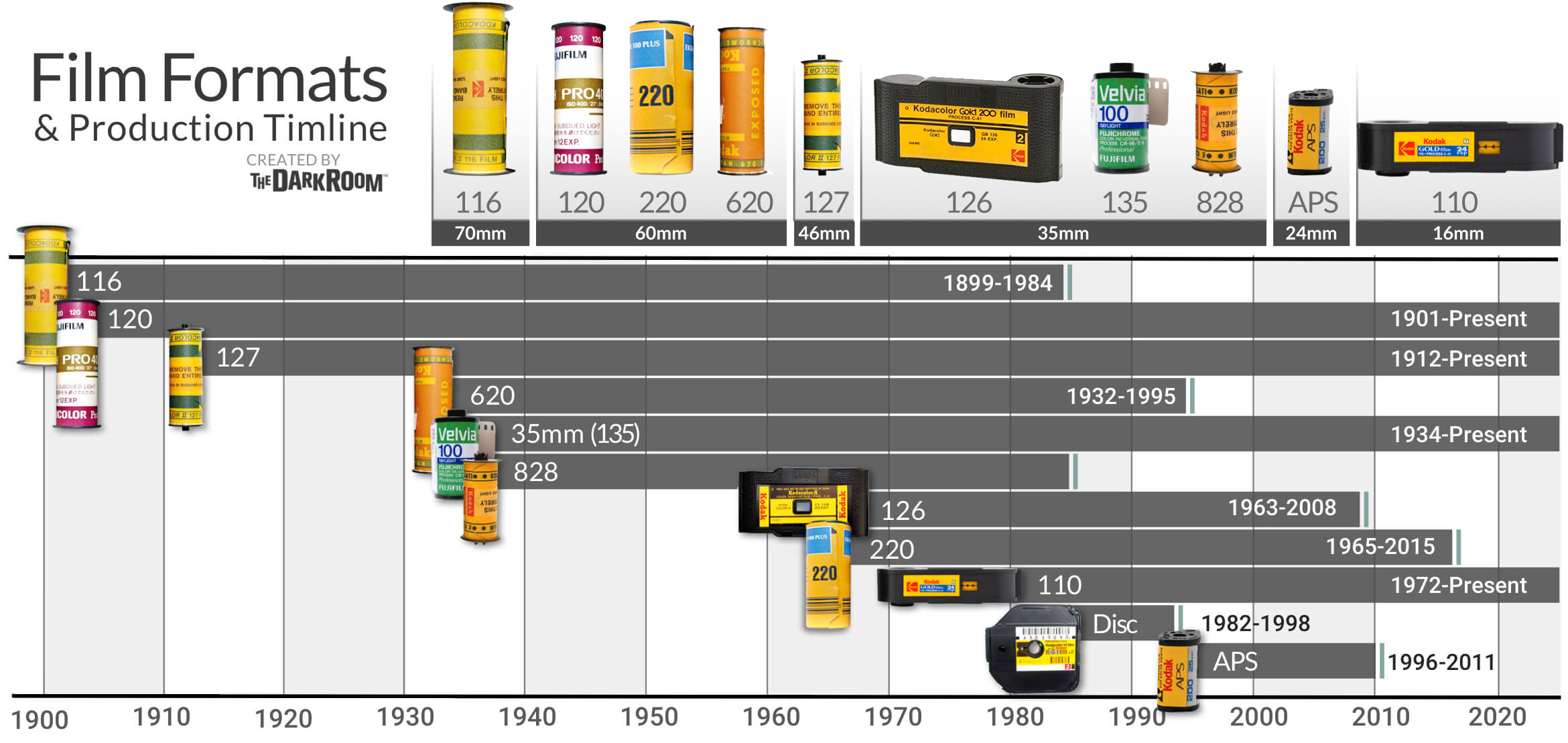116 Film (and 616)
Introduced in 1899 and discontinued in 1984
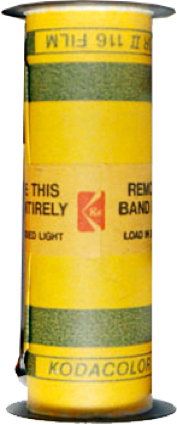 In 1932 Kodak introduced two new negative format, 620 and 616. The 70mm wide 616 film format ( 2½” ×4¼” or 6.5×11 cm) was the same as the existing 116 film format but the negative stock was wound on smaller spools in order to fit smaller cameras.
In 1932 Kodak introduced two new negative format, 620 and 616. The 70mm wide 616 film format ( 2½” ×4¼” or 6.5×11 cm) was the same as the existing 116 film format but the negative stock was wound on smaller spools in order to fit smaller cameras.
120 Film
Introduced in 1901
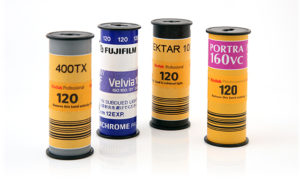 120 film is still a very popular medium format film, especially with the recent popularity of the Holga. The 120 film format was originally introduced by Eastman Kodak for its Brownie No. 2 in 1901.
120 film is still a very popular medium format film, especially with the recent popularity of the Holga. The 120 film format was originally introduced by Eastman Kodak for its Brownie No. 2 in 1901.
It was the main format for amateur photographers and beginners’ cameras like the box cameras. With the popularity of 35mm, 120 film became a format for professionals.
220 Film
Introduced in 1965
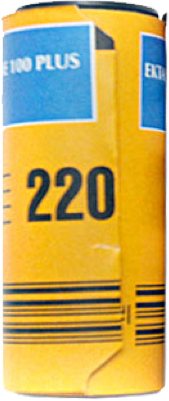 220 film is the same width as 120, but with double length (144 cm) and thus twice the number of exposures per roll. ISO 732 also specifies the dimensions of 220 film. Unlike 120, there is no backing paper behind the film itself, just a leader and a trailer. This allows a longer film on the same spool, but as a result, there are no printed frame numbers for old cameras that have a red window as a frame indicator. (Moreover, light from the window would fog the film.) Also, since the film alone is thinner than a film with backing paper, a differently positioned pressure plate may be required to achieve optimal focus. Some cameras capable of using both 120 and 220 film will have a two-position adjustment of the pressure plate (as well as a switch elsewhere to adjust winding), while others will require different film backs.
220 film is the same width as 120, but with double length (144 cm) and thus twice the number of exposures per roll. ISO 732 also specifies the dimensions of 220 film. Unlike 120, there is no backing paper behind the film itself, just a leader and a trailer. This allows a longer film on the same spool, but as a result, there are no printed frame numbers for old cameras that have a red window as a frame indicator. (Moreover, light from the window would fog the film.) Also, since the film alone is thinner than a film with backing paper, a differently positioned pressure plate may be required to achieve optimal focus. Some cameras capable of using both 120 and 220 film will have a two-position adjustment of the pressure plate (as well as a switch elsewhere to adjust winding), while others will require different film backs.
620 Film
Introduced in 1932 and discontinued in 1995
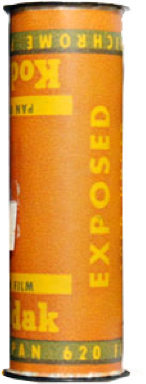 620 roll film is basically the same as 120 roll film; it has the same width and length. The only difference is the 620 spool that holds the film is smaller than that of the 120 rolls.
620 roll film is basically the same as 120 roll film; it has the same width and length. The only difference is the 620 spool that holds the film is smaller than that of the 120 rolls.
127 Film
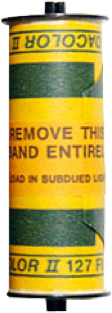 The 127 film is a paper-backed roll film, 4.6cm wide, originally designed to store eight pictures in 4×6.5cm format. It was created by Kodak for their Vest Pocket model – hence 127 was often called Vest Pocket film. Many of the first generations of 127 film cameras were similar folders, and frequently inherited Vest Pocket or VP in their names – for example, the Dolly Vest Pocket. See Category: 4×6.5.
The 127 film is a paper-backed roll film, 4.6cm wide, originally designed to store eight pictures in 4×6.5cm format. It was created by Kodak for their Vest Pocket model – hence 127 was often called Vest Pocket film. Many of the first generations of 127 film cameras were similar folders, and frequently inherited Vest Pocket or VP in their names – for example, the Dolly Vest Pocket. See Category: 4×6.5.
126 Film
Introduced in 1963
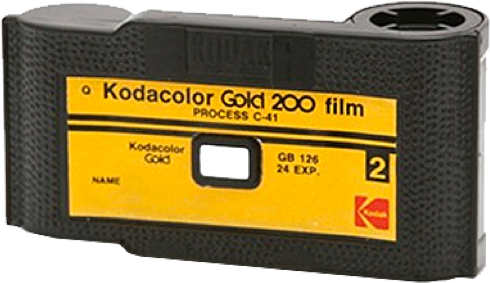 The Kodak 126 film cartridge is a roll film magazine for the 35mm-wide film with a paper backing.
The Kodak 126 film cartridge is a roll film magazine for the 35mm-wide film with a paper backing.
It was launched in 1963 by Kodak in answer to consumer complaints about the complications involved with loading and unloading roll film cameras. With the cartridge film, you don’t have to attach the film leader to a take-up spool. The cartridge simply drops into the camera. Since the cartridge is asymmetric, it cannot be loaded incorrectly. You close the back, wind, and shoot. 126 cameras have a window to show the back of the cartridge, which is printed with the film details and has a small hole revealing the frame number printed on the backing paper.
More on 126 Film
135 Film (35mm film canister)
Introduced in 1889
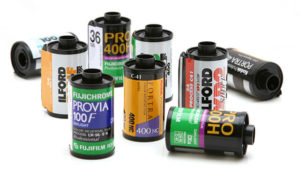 The 35mm film format was developed and produced at an experimental scale in Thomas A. Edison’s laboratory in New Jersey by splitting 70mm roll film. Edison compiled his caveat for the double perforated cine film in the fall of 1889, describing it as a double perforated long band passing from one reel to another, driven by two sprocket wheels. The film was obtained from the Eastman Dry Plate and film Company in Rochester, NY. However, it took several years to become a regular Kodak product.
The 35mm film format was developed and produced at an experimental scale in Thomas A. Edison’s laboratory in New Jersey by splitting 70mm roll film. Edison compiled his caveat for the double perforated cine film in the fall of 1889, describing it as a double perforated long band passing from one reel to another, driven by two sprocket wheels. The film was obtained from the Eastman Dry Plate and film Company in Rochester, NY. However, it took several years to become a regular Kodak product.
828 Film
Introduced in 1935
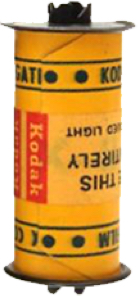 828 film was Kodak’s unperforated 35mm paper-backed roll film, introduced in 1935. 828 was intended to avoid some of the problems of the early perforated 35mm films. The smaller diameter spool and lack of need for a sprocket allowed for much smaller camera designs. Kodak’s Bantam camera series used 828 film.
828 film was Kodak’s unperforated 35mm paper-backed roll film, introduced in 1935. 828 was intended to avoid some of the problems of the early perforated 35mm films. The smaller diameter spool and lack of need for a sprocket allowed for much smaller camera designs. Kodak’s Bantam camera series used 828 film.
Other paper-backed 35mm film formats have included Bolta and the film Konishiroku produced for the Konilette.
More on 828 Film
APS Film
Introduced in 1996
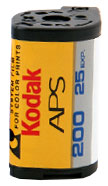 As an alternative to 110 formats, The APS film cartridges are optimized for fully automatic film load, enclosing the 24mm wide film completely when not in use. A lightproof door and partially exposed films can, in certain cameras, be removed and used later. The film is even put back into its cartridge and returned to the user after it has been developed.
As an alternative to 110 formats, The APS film cartridges are optimized for fully automatic film load, enclosing the 24mm wide film completely when not in use. A lightproof door and partially exposed films can, in certain cameras, be removed and used later. The film is even put back into its cartridge and returned to the user after it has been developed.
110 Film
Introduced in 1972
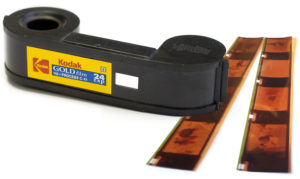 110 film cartridges were launched by Kodak in answer to consumer complaints about the complications involved with loading and unloading roll film cameras. Because loading film was easy and the small size made 110 format popular very quickly.
110 film cartridges were launched by Kodak in answer to consumer complaints about the complications involved with loading and unloading roll film cameras. Because loading film was easy and the small size made 110 format popular very quickly.
The small negative size of 110 film is half the size of 135 (35mm) film and because it’s small it’s difficult to enlarge and get high-resolution scans and the film is often associated with prints and scans that are grainy and lacking sharpness.





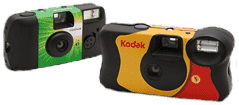
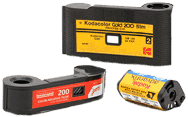
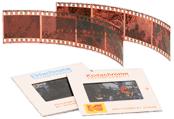






 Gift Cards
Gift Cards Film Index
Film Index FAQ
FAQ Desktop Framed Prints
Desktop Framed Prints